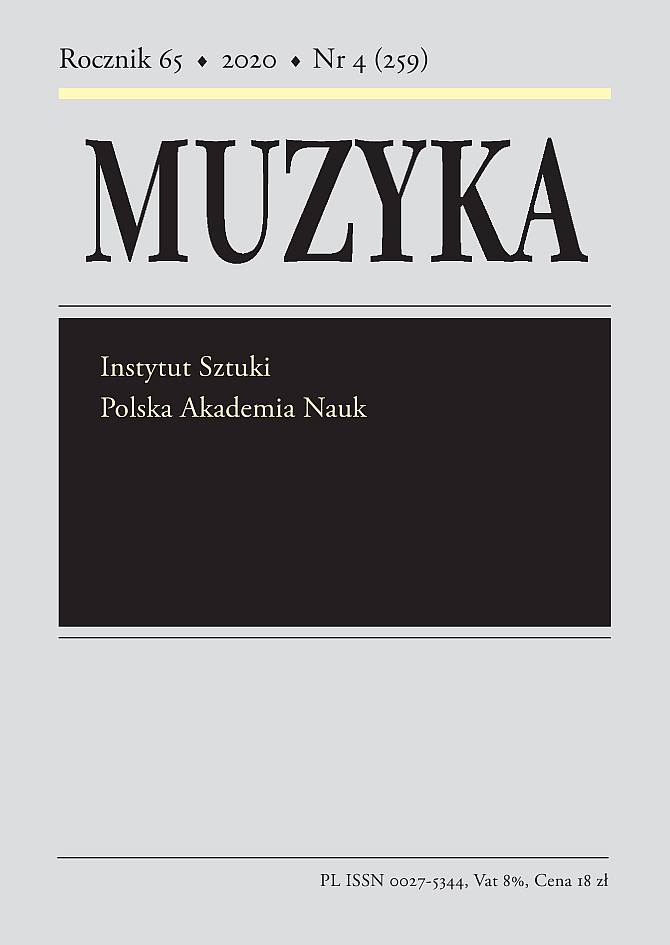Przyczynek do historii przyjaźni Stefana Jarocińskiego i Witolda Lutosławskiego. Listy kompozytora przechowywane w Dziale Zbiorów Specjalnych Instytutu Sztuki PAN (1947–1961)
Toward a Historical Study of the Friendship between Stefan Jarociński and Witold Lutosławski. The Composer’s Letters kept in the Special Collections of the Institute of Art, Polish Academy of Sciences (1947–1961)
Author(s): Małgorzata SieradzSubject(s): Music
Published by: Instytut Sztuki Polskiej Akademii Nauk
Keywords: Polish contemporary music; history of Polish musicology; cultural life in the 1950s
Summary/Abstract: This is a brief paper presenting materials related to the person and work of Witold Lutosławski, preserved in the archive of Stefan Jarociński (which has been part of the Polish Academy of Sciences, Institute of Art’s Special Collections since the autumn of 2017). The archive includes, among others, 13 letters which testify to the long-standing friendship between these two eminent personalities, as well as materials collected by Jarociński during his work on publications concerning the person and oeuvre of the composer of Mi-parti.The friendship between Jarociński, one of the main representatives of the 2nd generation of Polish musicologists, and Lutosławski, who is included in the pantheon of the century’s most outstanding composers, is a moving example of relations between great personalities in Polish culture in the 2nd half of the 20th century. They had met as students at Warsaw’s Stefan Batory Grammar School. Years later the ex-schoolmates became close friends. Their contact was interrupted during WWII. Following the war they first met in Paris (1946), where Jarociński settled after the liberation of Murnau POW camp (Oflag), and where Lutosławski came to attend a UNESCO concert featuring, among others, his Symphonic Variations. Over the period of three months in late 1946 and early 1947 they spent much time together, largely in the Paris neighbourhood of Battignoles, of which the composer grew particularly fond. Shortly after coming back to Poland, on 10th March 1947 Lutosławski sent his friend a letter, in which he encouraged Jarociński to return and tempted him with the prospect of taking up the then vacant post of journalist in the Polish Radio Theatre. In later letters, the composer shared his impressions of artistic events, but also wrote about his personal life, mentioning, among others, Michał Spisak, who was likewise Jarociński’s friend.Lutosławski’s works inspired Jarociński so much that they quite soon became the object of his analyses and studies. He presented the composer’s portrait in the inaugural issue of his column ‘Artist Profiles’ printed in Przegląd Kulturalny [Culture Review]. In the same period, Jarociński took up a post at the State Institute of Art (the later Institute of Art of the Polish Academy of Sciences), where, apart from studying the history of Polish music criticism and late 19th- / early 20th-century music, he returned several times to Lutosławski’s output (in articles and reviews printed in the Institute’s periodicals: Muzyka (monthly and quarterly) as well as Studia Muzykologiczne [Musicological Studies] and Materiały do Studiów i Dyskusji z Zakresu Teorii i Historii Sztuki, Krytyki Artystycznej oraz Metodologii Badań nad Sztuką [Materials for the Study and Discussion of Art Theory and History, Art Criticism, and Methodology of Research on Art]. He also planned to write a monograph dedicated to that composer. Lutosławski responded to these frequent manifestations of friendship by dedicating to Jarociński’s memory his Grave, which opens with the ‘forest motif’ from Pelléas et Mélisande, quoted there as a symbolic homage to Jarociński’s scholarly passion.My paper is accompanied by an edition of the 13 previously unknown and unpublished letters written by Witold Lutosławski to Stefan Jarociński in 1947–1961. The study of these documents, in correlation with that of the correspondence between Jarociński and Polish Chopin scholar, musicologist Ludwik Bronarski (preserved at the Polish Catholic Mission in Marly), with which I have been able to become acquainted, has made it possible for me to describe for the first time or shed light on several episodes from the lives of both Jarociński and Lutosławski.
Journal: Muzyka
- Issue Year: 65/2020
- Issue No: 4
- Page Range: 139-170
- Page Count: 32
- Language: Polish

